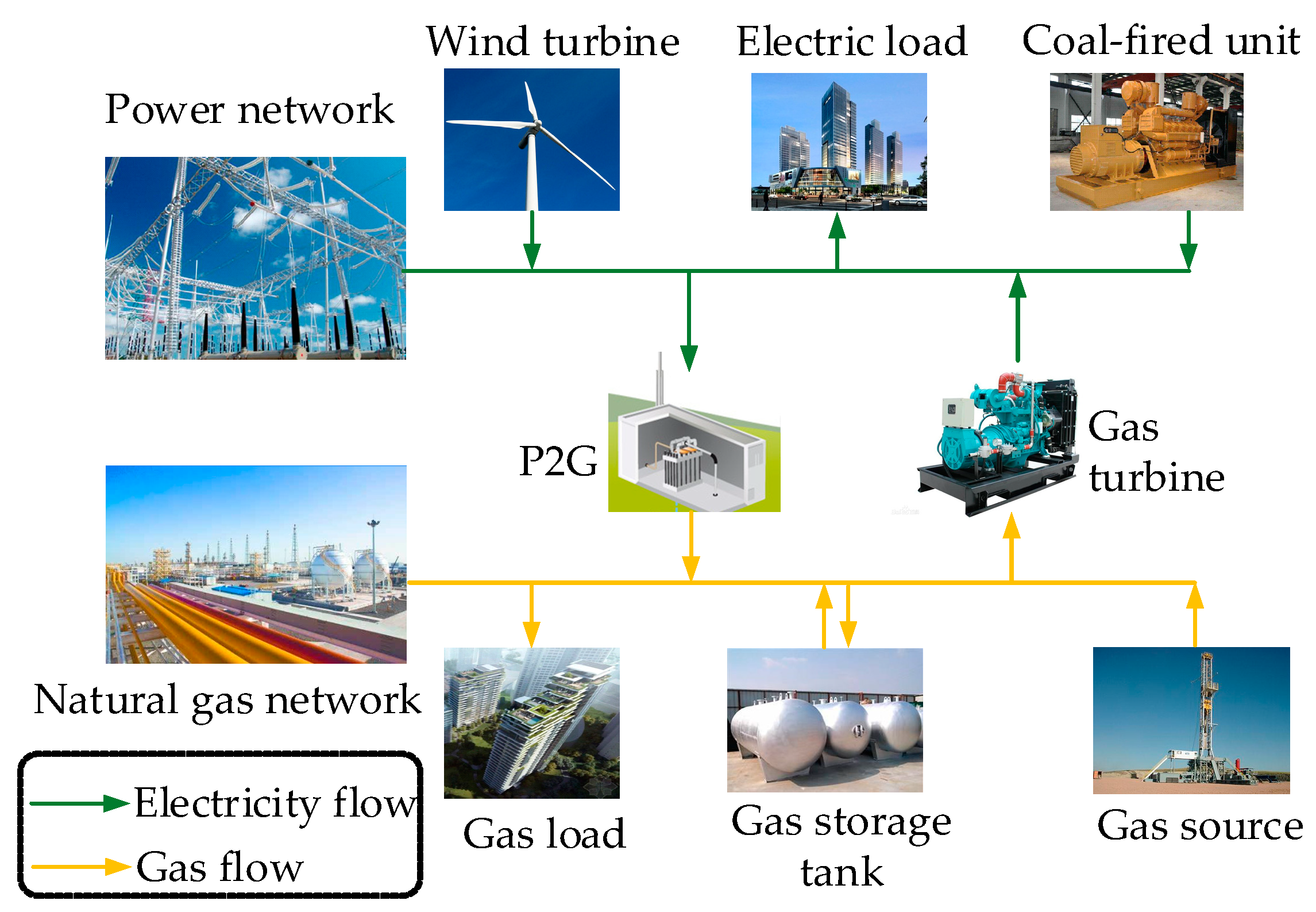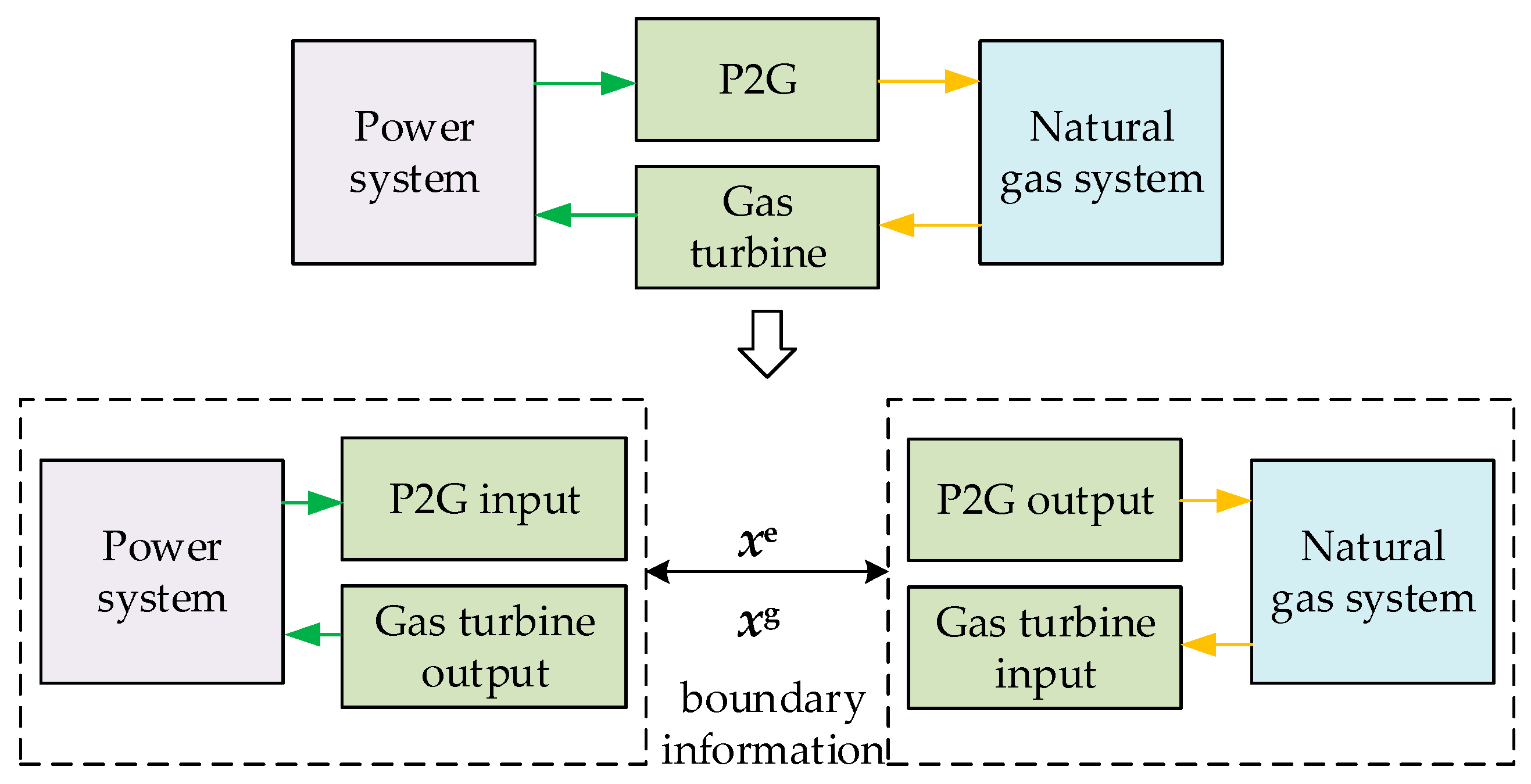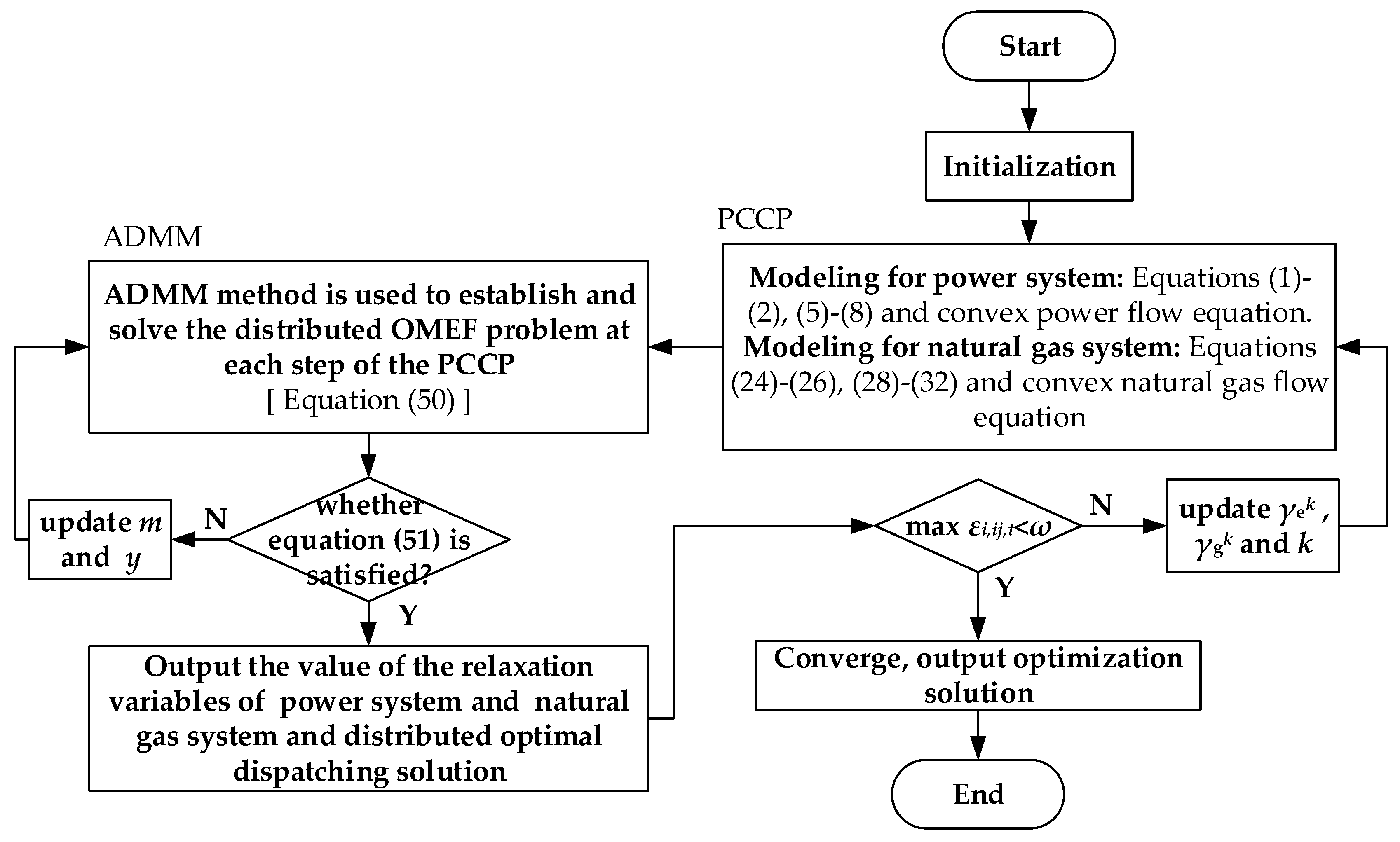Decentralized Optimization of Electricity-Natural Gas Flow Considering Dynamic Characteristics of Networks
Abstract
:1. Introduction
- The non-convex OMEF problem is transformed into a convex optimization problem by PCCP. For the power system model, based on the paper [25], this paper studies the method of convexity of the second-order power flow equation in the multi-period OMEF model, which effectively retains all the electrical quantities and is suitable for any topology. For the natural gas system model considering the dynamic characteristics, the positive and negative natural gas flow are introduced into the model, and the PCCP method is used to convexize the flow equation, which can efficiently solve the natural gas system model.
- The decentralized optimization process is based on the obtained convex OMEF model. At each iteration of the PCCP, ADMM is used to establish and solve the decentralized OMEF problem of IEGS. During the solution process, each system only needs to exchange a small amount of boundary information, which achieves independent optimization and partition coordination. The solution process ensures the privacy and security of each system information. Finally, testing IEGS combined with an IEEE 39-bus power system and a Belgian 20-bus natural gas system is used to verify the proposed algorithm and can effectively solve the decentralized OMEF problem.
2. Modeling for OMEF
2.1. Power System
2.1.1. Modeling for Power System
2.1.2. Power Balance Equation Convex Relaxation
2.2. Natural Gas System
2.2.1. Modeling for Natural Gas System
2.2.2. Natural Gas Flow Equation Convex Relaxation
2.3. Modeling for Coupling Elements
2.4. Objectives of OMEF
3. Decentralized Optimal Scheduling of OMEF for IEGS
3.1. Decentralized Framework
3.2. Decentralized Algorithm
3.3. Flowchart of Decentralized OMEF Optimization Algorithm
4. Case Studies
4.1. Simulation Model Description
4.2. Analysis of the Algorithm
4.3. Analysis of Optimization Results
- (1)
- Case 1: Regardless of the dynamic characteristics of the natural gas system (i.e., removing the Equations (24)–(26)), the objective is to optimize the cost of energy supply.
- (2)
- Case 2: Considering the dynamic characteristics of the natural gas system, the objective is to optimize the cost of energy supply.
5. Conclusions
- (1)
- For the non-convex OMEF model, this paper introduces the PCCP method to transform the non-convex OMEF problem into a convex programming problem, and proves the feasibility of the method from theoretical and simulation results.
- (2)
- This article analyzes the impact of the line pack on system performance. The calculation results show that considering the dynamic characteristics of the natural gas system can improve the flexibility and economy of the system.
- (3)
- Considering the privacy of the information of each subsystem in IEGS, this paper proposes a decentralized optimization algorithm for the OMEF problem based on PCCP-ADMM. In decentralized optimization, each system only needs to exchange a small amount of information to perform global coordination and optimization.
Author Contributions
Funding
Acknowledgments
Conflicts of Interest
Appendix A

| Units | Cost Factor | Maximum Output | |||
|---|---|---|---|---|---|
| Active Output (MW) | Reactive Output (MVar) | ||||
| a2 | a1 | a0 | |||
| GM1 | 0.700 | 26.987 | 0 | 646 | 300 |
| GM2 | 0.682 | 21.978 | 0 | 725 | 300 |
| GM3 | 0.425 | 25.00 | 0 | 687 | 300 |
| GM4 | 0.458 | 26.098 | 0 | 865 | 300 |
| GM5 | 0.890 | 26.176 | 0 | 1100 | 300 |
| bi | |||||
| GT1 | 0.25 | 1040 | 400 | ||
| GT2 | 0.25 | 580 | 240 | ||
| GT3 | 0.25 | 564 | 250 | ||
| di | |||||
| WT1 | 50 | 652 | 250 | ||
| WT2 | 50 | 508 | 167 | ||
| Units | Cost Factor ci($/m3) | Minimum Output (m3/s) | Maximum Output (m3/s) |
|---|---|---|---|
| S1 | 0.25 | 10.3 | 105.5 |
| S2 | 0.25 | 12.0 | 104.2 |
| Units | ||
|---|---|---|
| P2G1 | 0.6 | 39 |
| P2G2 | 0.6 | 39 |
| Units | z2,i | z1,i | z0,i |
|---|---|---|---|
| GT1 | 0.0769 | 5.9769 | 0 |
| GT2 | 0.0450 | 5.4692 | 0 |
| GT2 | 0.0601 | 5.5242 | 0 |
References
- Wang, C.; Lv, C.; Li, P.; Song, G.; Li, S.; Xu, X.; Wu, J. Modeling and optimal operation of community integrated energy systems: A case study from China. Appl. Energy 2018, 230, 1242–1254. [Google Scholar] [CrossRef]
- Behar, O. A novel hybrid solar preheating gas turbine. Energy Convers. Manag. 2018, 158, 120–132. [Google Scholar] [CrossRef]
- Kirchbacher, F.; Biegger, P.; Miltner, M.; Lehner, M.; Harasek, M. A new methanation and membrane based power-to-gas process for the direct integration of raw biogas—Feasability and comparison. Energy 2017, 146, 34–46. [Google Scholar] [CrossRef]
- Zhou, K.; Yang, S.; Shao, Z. Energy Internet: The business perspective. Appl. Energy 2016, 178, 212–222. [Google Scholar] [CrossRef]
- Nastasi, B.; Basso, G.L. Power-to-Gas integration in the Transition towards Future Urban Energy Systems. Int. J. Hydrogen Energy 2017, 42, 23933–23951. [Google Scholar] [CrossRef]
- Liu, W.; Wen, F.; Xue, Y. Power-to-gas technology in energy systems: Current status and prospects of potential operation strategies. J. Mod. Power Syst. Clean Energy 2017, 5, 439–450. [Google Scholar] [CrossRef] [Green Version]
- Shahidehpour, M.; Fu, Y.; Wiedman, T. Impact of Natural Gas Infrastructure on Electric Power Systems. Proc. IEEE 2005, 93, 1042–1056. [Google Scholar] [CrossRef]
- Urbina, M.; Li, Z. A combined model for analyzing the interdependency of electrical and gas systems. In Proceedings of the 2007 39th North American Power Symposium, Las Cruces, NM, USA, 30 September–2 October 2007; pp. 468–472. [Google Scholar]
- Martinez-Mares, A.; Fuerte-Esquivel, C.R. A Unified Gas and Power Flow Analysis in Natural Gas and Electricity Coupled Networks. IEEE Trans. Power Syst. 2012, 27, 2156–2166. [Google Scholar] [CrossRef]
- Correa-Posada, C.M.; Sanchez-Martin, P. Integrated Power and Natural Gas Model for Energy Adequacy in Short-Term Operation. IEEE Trans. Power Syst. 2015, 30, 3347–3355. [Google Scholar] [CrossRef]
- Shahidehpour, M.; Liu, C.; Wang, J. Cordinated scheduling of electricity and natural gas infrastructures with a transient model for natural gas flow. Chaos 2011, 21, 025102. [Google Scholar]
- Fang, J.; Zeng, Q.; Ai, X.; Chen, Z.; Wen, J. Dynamic Optimal Energy Flow in the Integrated Natural Gas and Electrical Power Systems. IEEE Trans. Sustain. Energy 2017, 9, 188–198. [Google Scholar] [CrossRef]
- Chen, X.; Wang, C.; Wu, Q.; Dong, X.; Yang, M.; He, S.; Liang, J. Optimal operation of integrated energy system considering dynamic heat-gas characteristics and uncertain wind power. Energy 2020, 198, 117270. [Google Scholar] [CrossRef]
- Wang, S.; Wang, S.; Chen, H.; Gu, Q. Multi-energy load forecasting for regional integrated energy systems considering temporal dynamic and coupling characteristics. Energy 2020, 195, 116964. [Google Scholar] [CrossRef]
- Bao, Z.; Ye, Y.; Wu, L. Multi-timescale coordinated schedule of interdependent electricity-natural gas systems considering electricity grid steady-state and gas network dynamics. Int. J. Electr. Power Energy Syst. 2020, 118, 105763. [Google Scholar] [CrossRef]
- Qu, K.; Zheng, B.; Yu, T.; Li, H. Convex decoupled-synergetic strategies for robust multi-objective power and gas flow considering power to gas. Energy 2019, 168, 753–771. [Google Scholar] [CrossRef]
- He, Y.; Yan, M.; Shahidehpour, M.; Li, Z.; Guo, C.; Wu, L.; Shao, C. Decentralized Optimization of Multi-Area Electricity-Natural Gas Flows Based on Cone Reformulation. IEEE Trans. Power Syst. 2018, 33, 4531–4542. [Google Scholar] [CrossRef]
- Qu, K.; Shi, S.; Yu, T.; Wang, W. A convex decentralized optimization for environmental-economic power and gas system considering diversified emission control. Appl. Energy 2019, 240, 630–645. [Google Scholar] [CrossRef]
- Stott, B.; Jardim, J.; Alsac, O. DC Power Flow Revisited. IEEE Trans. Power Syst. 2009, 24, 1290–1300. [Google Scholar] [CrossRef]
- Jabr, R.A. Radial Distribution Load Flow Using Conic Programming. IEEE Trans. Power Syst. 2006, 21, 1458–1459. [Google Scholar] [CrossRef]
- Correa-Posada, C.M.; Sanchez-Martin, P. Security-Constrained Optimal Power and Natural-Gas Flow. IEEE Trans. Power Syst. 2014, 29, 1780–1787. [Google Scholar] [CrossRef]
- Bischi, A.; Taccari, L.; Martelli, E.; Amaldi, E.; Manzolini, G.; Silva, P.; Campanari, S.; Macchi, E. A detailed MILP optimization model for combined cooling, heat and power system operation planning. Energy 2014, 74, 12–26. [Google Scholar] [CrossRef]
- Wang, C.; Wei, W.; Wang, J.; Bai, L.; Liang, Y.; Bi, T. Convex Optimization Based Distributed Optimal Gas-Power Flow Calculation. IEEE Trans. Sustain. Energy 2018, 9, 1145–1156. [Google Scholar] [CrossRef]
- Wang, C.; Wei, W.; Wang, J.; Wu, L.; Liang, Y. Equilibrium of Interdependent Gas and Electricity Markets with Marginal Price Based Bilateral Energy Trading. IEEE Trans. Power Syst. 2018, 33, 4854–4867. [Google Scholar] [CrossRef]
- Tian, Z.; Wu, W. Recover Feasible Solutions for SOCP Relaxation of Optimal Power Flow Problems in Mesh Networks. IET Gener. Transm. Distrib. 2019, 13, 1078–1087. [Google Scholar] [CrossRef] [Green Version]
- Low, S.H. Convex Relaxation of Optimal Power Flow—Part I: Formulations and Equivalence. IEEE Trans. Control Netw. Syst. 2014, 1, 15–27. [Google Scholar] [CrossRef] [Green Version]
- Van Hertem, D.; Verboomen, J.; Purchala, K.; Belmans, R.; Kling, W. Usefulness of DC power flow for active power flow analysis with flow controlling devices. In Proceedings of the 8th IEE International Conference on AC and DC Power Transmission, London, UK, 28–31 March 2006; pp. 58–62. [Google Scholar]
- Coffrin, C.J.; Hijazi, H.L.; Van Hentenryck, P. The QC Relaxation: A Theoretical and Computational Study on Optimal Power Flow. IEEE Trans. Power Syst. 2016, 31, 3008–3018. [Google Scholar] [CrossRef]








| Algorithm | Parameters | ||||
|---|---|---|---|---|---|
| PCCP | power system | ||||
| 10 | 1000 | 2 | 0.1 | ||
| natural gas system | |||||
| 0.1 | 100 | 2 | 0.01 | ||
| ADMM | ρ | τ | |||
| 1000 | 0.01 | ||||
| Algorithm | Objective($) | Iteration | Time(s) | |
|---|---|---|---|---|
| centralized optimization | NLP | 5.3164 × 106 | 83 | 4.19 |
| PCCP | 4.9680 × 106 | 5 | 45.26 | |
| decentralized optimization | PCCP-ADMM | 4.9881 × 106 | 22 | 68.18 |
| Case | Objective($) | Reduction (%) |
|---|---|---|
| 1 | 5.0267 × 106 | 0.77 |
| 2 | 4.9881 × 106 |
© 2020 by the authors. Licensee MDPI, Basel, Switzerland. This article is an open access article distributed under the terms and conditions of the Creative Commons Attribution (CC BY) license (http://creativecommons.org/licenses/by/4.0/).
Share and Cite
Wu, W.; Yu, T.; Li, Z.; Zhu, H. Decentralized Optimization of Electricity-Natural Gas Flow Considering Dynamic Characteristics of Networks. Appl. Sci. 2020, 10, 3348. https://doi.org/10.3390/app10103348
Wu W, Yu T, Li Z, Zhu H. Decentralized Optimization of Electricity-Natural Gas Flow Considering Dynamic Characteristics of Networks. Applied Sciences. 2020; 10(10):3348. https://doi.org/10.3390/app10103348
Chicago/Turabian StyleWu, Weicong, Tao Yu, Zhuohuan Li, and Hanxin Zhu. 2020. "Decentralized Optimization of Electricity-Natural Gas Flow Considering Dynamic Characteristics of Networks" Applied Sciences 10, no. 10: 3348. https://doi.org/10.3390/app10103348
APA StyleWu, W., Yu, T., Li, Z., & Zhu, H. (2020). Decentralized Optimization of Electricity-Natural Gas Flow Considering Dynamic Characteristics of Networks. Applied Sciences, 10(10), 3348. https://doi.org/10.3390/app10103348





